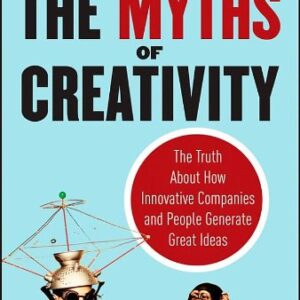Product Description
How to get past the most common myths about creativity to design truly innovative strategies
We tend to think of creativity in terms reminiscent of the ancient muses: divinely-inspired, unpredictable, and bestowed upon a lucky few. But when our jobs challenge us to be creative on demand, we must develop novel, useful ideas that will keep our organizations competitive. The Myths of Creativity demystifies the processes that drive innovation. Based on the latest research into how creative individuals and firms succeed, David Burkus highlights the mistaken ideas that hold us back and shows us how anyone can embrace a practical approach, grounded in reality, to finding the best new ideas, projects, processes, and programs.
- Answers questions such as: What causes us to be creative in one moment and void in the next? What makes someone more or less creative than his or her peers? Where do our flashes of creative insight come from, and how can we generate more of them?
- Debunks 10 common myths, including: the Eureka Myth; the Lone Creator Myth; the Incentive Myth; and The Brainstorming Myth
- Written by David Burkus, founder of popular leadership blog LDRLB
For anyone who struggles with creativity, or who makes excuses for delaying the work of innovation, The Myths of Creativity will help you overcome your obstacles to finding new ideas.
Amazon.com Review
Q&A with David Burkus, author of The Myths of Creativity

David Burkus
Why is creativity in the business world so vague and inaccessible?
The roots of it go back to our tendency to develop myths in the first place. When we as humans don't understand how something works, we usually develop some kind of educated guess or heuristic about it. Over time these heuristics become fully entrenched myths that can be hard to abandon. In the case of business, so much of "management" education teaches us to rely on solid principles and formulas that have been refined through the decades. Creativity, until recently, wasn't like that. It was hard to reduce to a set of defined metrics, and so many in business abandoned it all together, relying on outsourcing when needed to "creative" firms. Thankfully, decades of psychological insight into creativity have given us a means to study where it comes from and how to enhance it for greater innovation.
How can managers in the business world better understand what creativity is and where it comes from?
It starts by leaving the myths behind. The stories and heuristics we used to explain creativity and innovation aren't necessary and, in many cases, are contradictory to the empirical evidence. By beginning to study that evidence, managers will develop a better understanding of how great ideas develop and how to develop organizations that can consistently produce great ideas. Innovation will follow.
How did you determine the ten myths of creativity?
The myths actually grew from some research I began during my final few years of doctoral studies. I had focused on the relationship between leadership and innovation and was pretty orientated with what the literature had to say about how innovation happens. However, as I looked at how most organizations operated, they appeared to be misaligned with the evidence. As I looked deeper into these faulty beliefs and the motivations behind them, I came to realize how similar they were to the Greeks' mythology around creativity. No one still believes in the nine muses, but they do tell themselves a whole new set of myths of creativity.
Which myth is the one that almost all companies subscribe to and can be the most crippling?
I close the book with a discussion of the "Mousetrap Myth," the belief that once a good idea is generated, getting it implemented is easy. This comes from the maxim "If you build a better mousetrap, the world will beat a path to your door." It turns out that this saying is quite backwards. In most cases, when a great idea or innovation is presented to the world it is typically rejected at first. The digital camera, personal computers, and even talking pictures were all at first dismissed as nonsense. In most cases, if you build a better mousetrap, the world will beat you down and ignore your idea. The reason for this is most likely a psychological bias we all share against creative ideas. We say we want more creativity, but when we are presented with new ideas, we have a hard time recognizing their utility. This is something I see in almost all organizations.
Great ideas come from all levels of an organization, but pushing them through this bias at every level of the hierarchy is a long and arduous process that most people give up in the middle of. In this way, most organizations kill their most of their innovative ideas. Not all organizations are afflicted, though, many organizations have taken deliberate steps to counteract the bias and cultivate great ideas. Not surprisingly, those are the organizations seen at the top of so many "most innovative" or "great place to work" lists and experiencing outstanding growth in their industry.
 Digabyss.com
Digabyss.com


Reviews
There are no reviews yet.